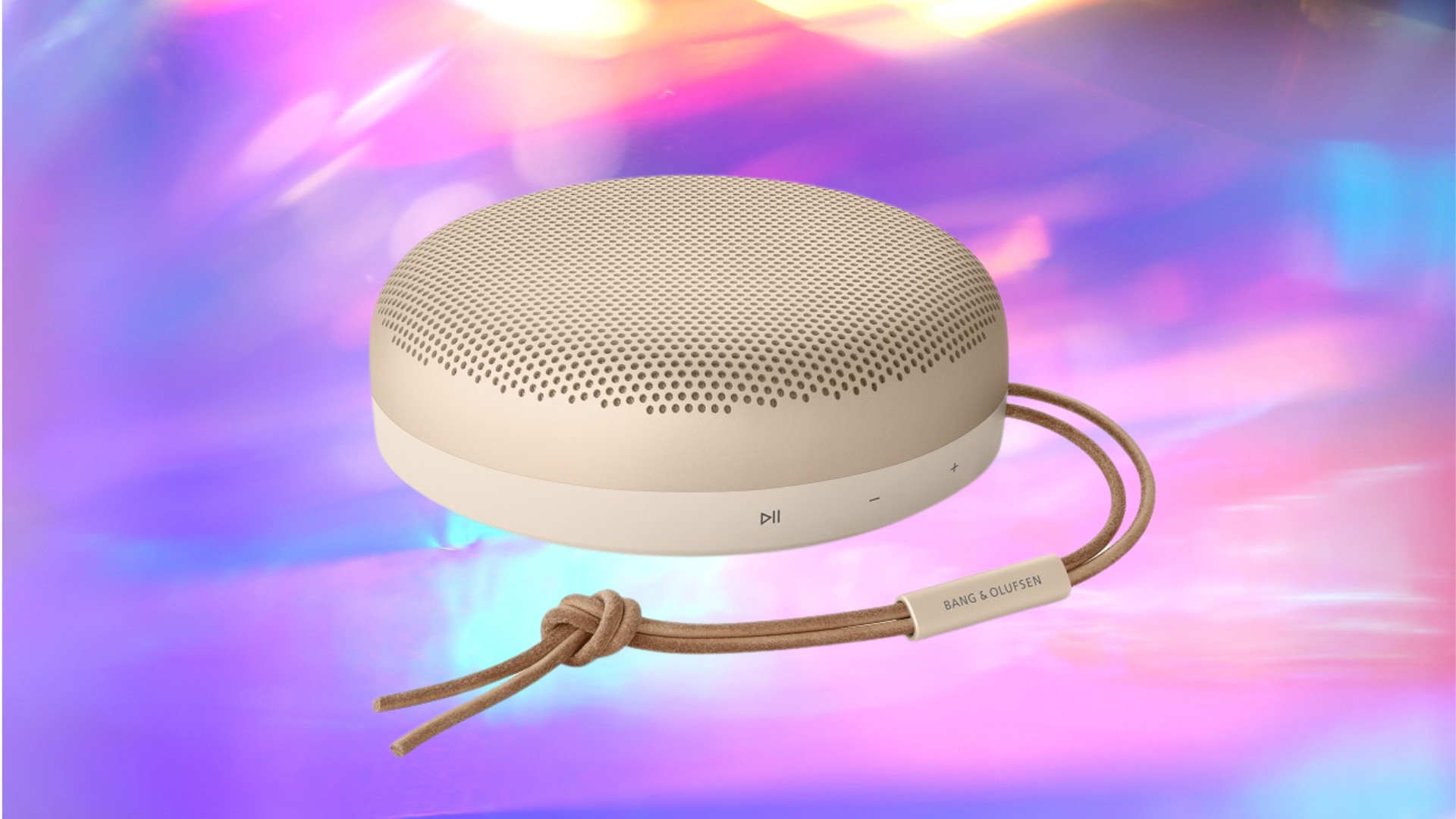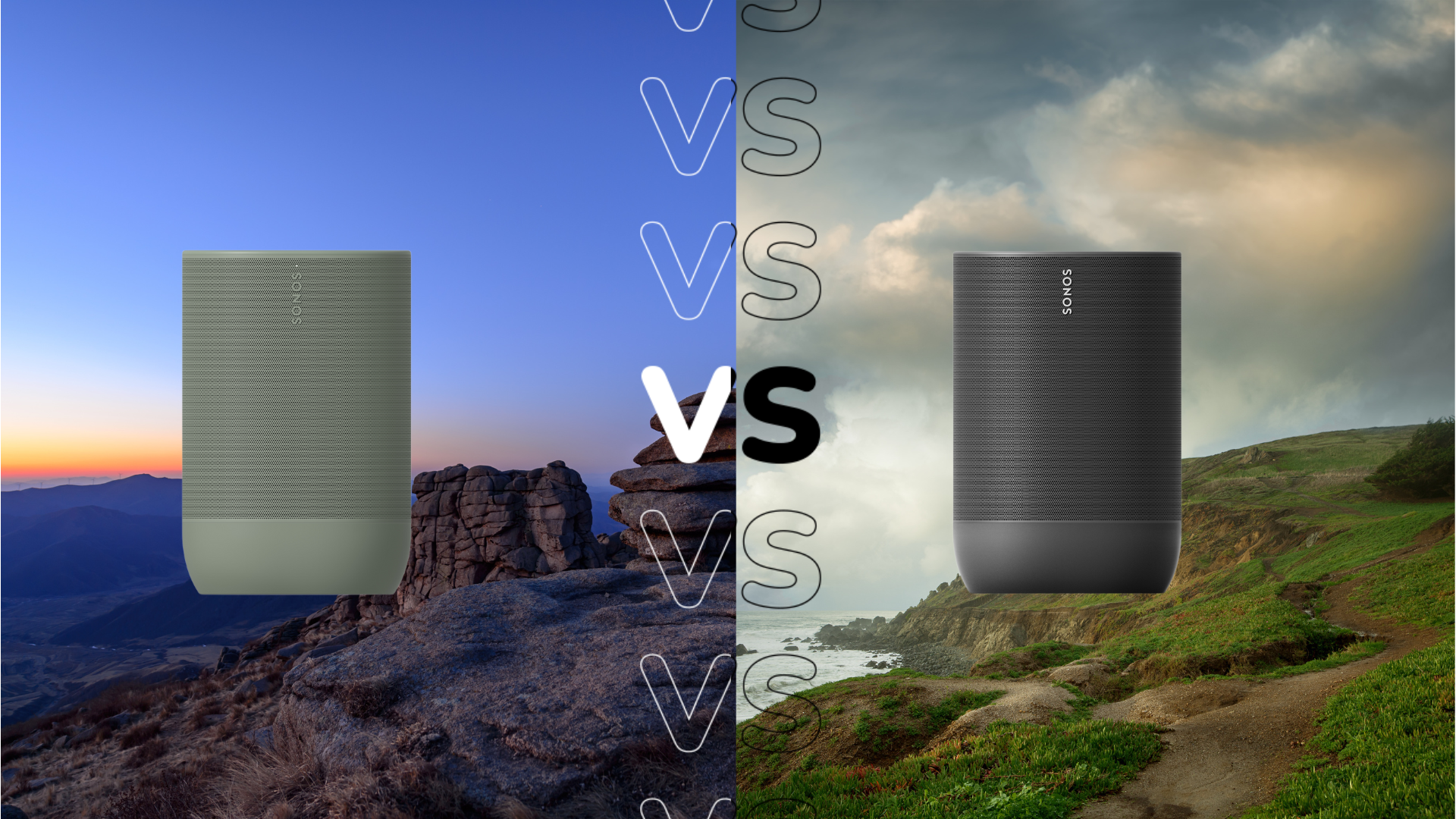Sonos Move 2 Review
More battery life, better audio.
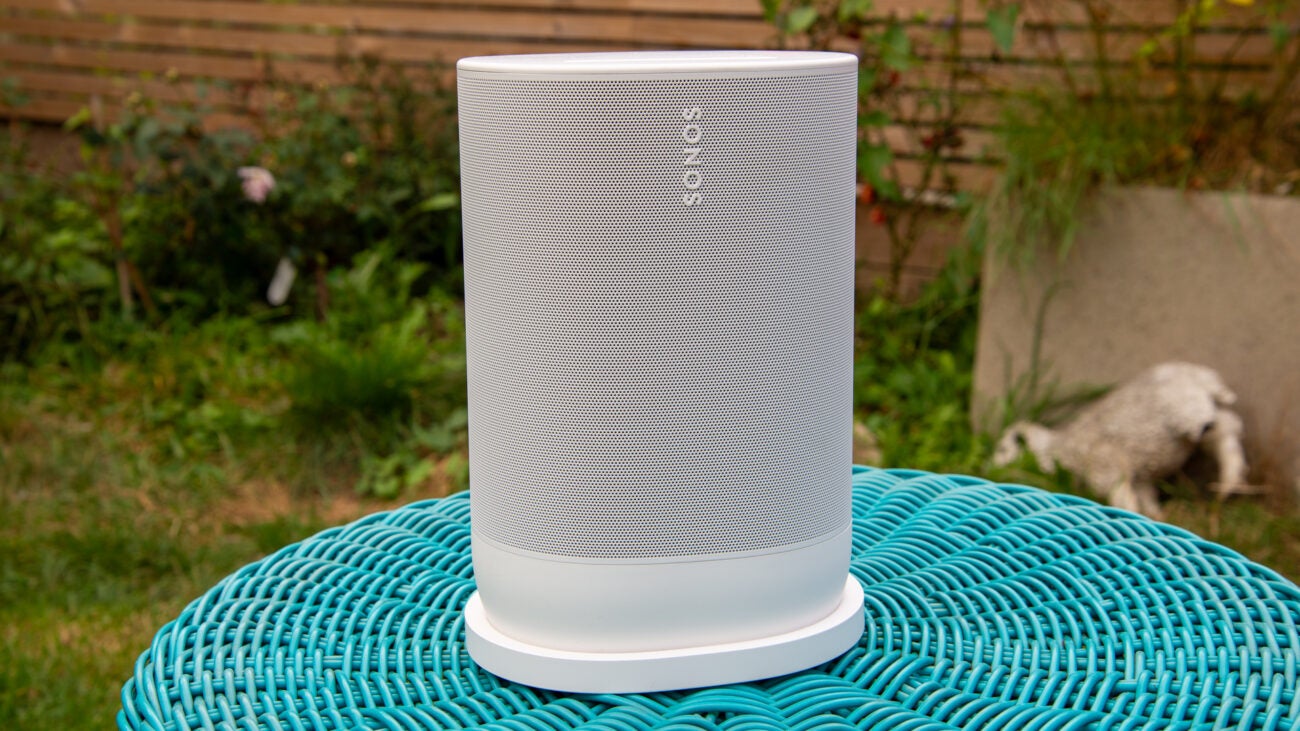

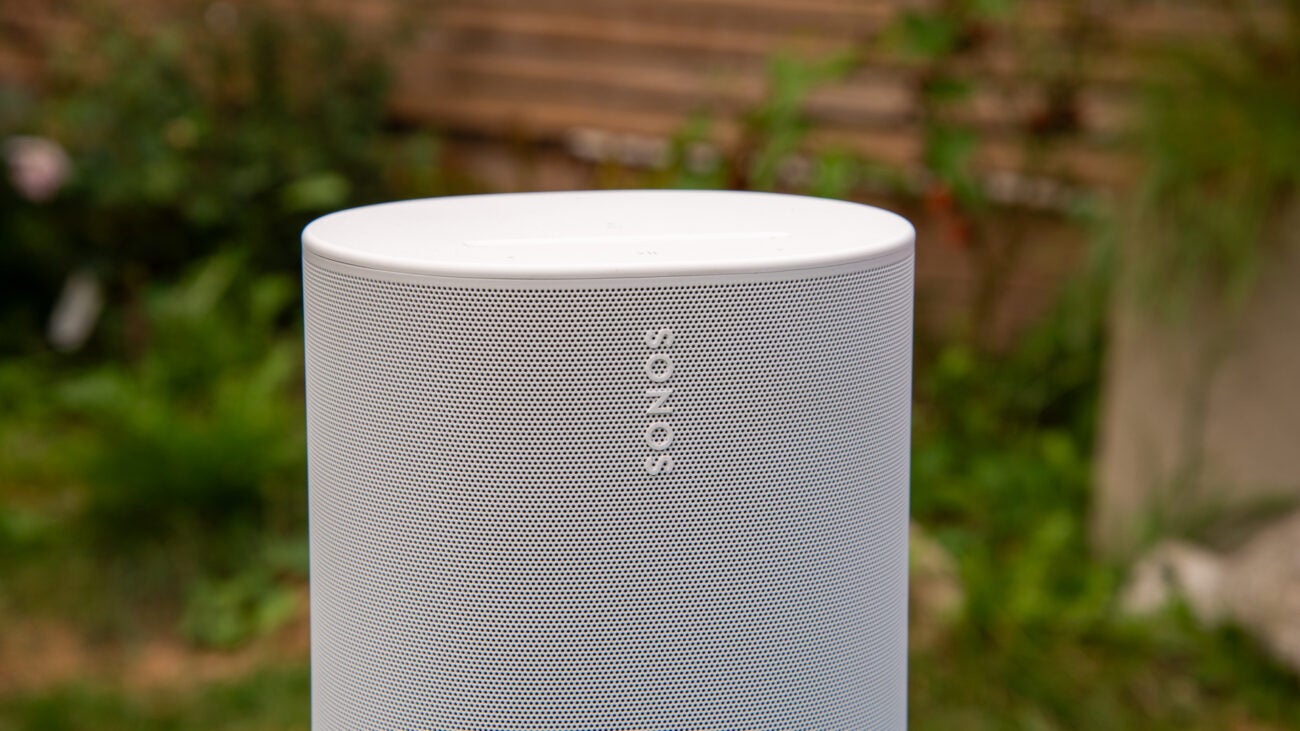

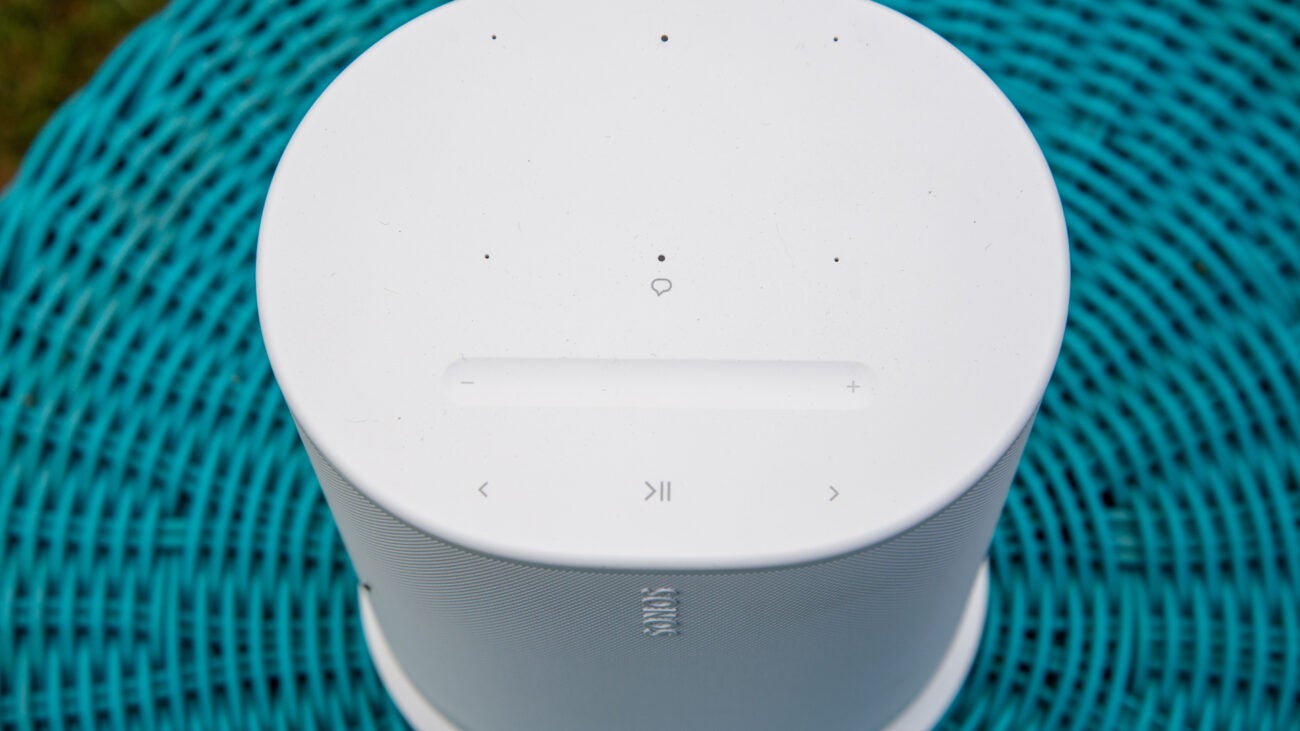


Verdict
With its redesigned audio system, the Sonos Move 2 adds two tweeters into the mix to deliver stereo, as well as a wider, less positional soundscape than its predecessor. There’s no escaping that this is an expensive speaker, but there’s nothing else that can quite do what the Move 2 can: it’s a proper, fully integrated Sonos speaker that works as well inside and out, capable of running on Wi-Fi or Bluetooth. And with more than double the battery life of the original, this is a speaker that keeps going
Pros
- Excellent battery life
- High-quality audio
- Works as a regular Sonos speaker at home
Cons
- Expensive
- Line-in adaptor is optional extra
Key Features
- 24-hour battery lifeRuns for up to 24-hours on a full charge, easily doubling the playback time of the previous model
- ConnectionsRuns on Wi-Fi for Sonos and AirPlay 2, supports Bluetooth 5 and has a USB-C line-in.
Introduction
When Sonos entered the portable speaker market in 2019, the Move differed to its competition. Rather than designed to slip in a bag and be carried everywhere, the Move was built like a traditional indoor Sonos speaker, only it had a battery and was sealed against the elements. Now, the company is back for more with the Sonos Move 2.
A redesigned speaker system, with stereo tweeters, and all-day battery life, the new speaker is for those that want quality audio inside and out.
Design
- 3kg weight
- Integrated carry handle
- IP56 rated
There’s not a lot of difference from the outside between the old Move and the Move 2, more of a tweak in design. That’s alright with me, as the original already looked stylish, so there’s not much point in starting from fresh.
Once again, the speaker is available in three colours. I really like the green model, but I’ve got the white for review, and there’s also a black version.
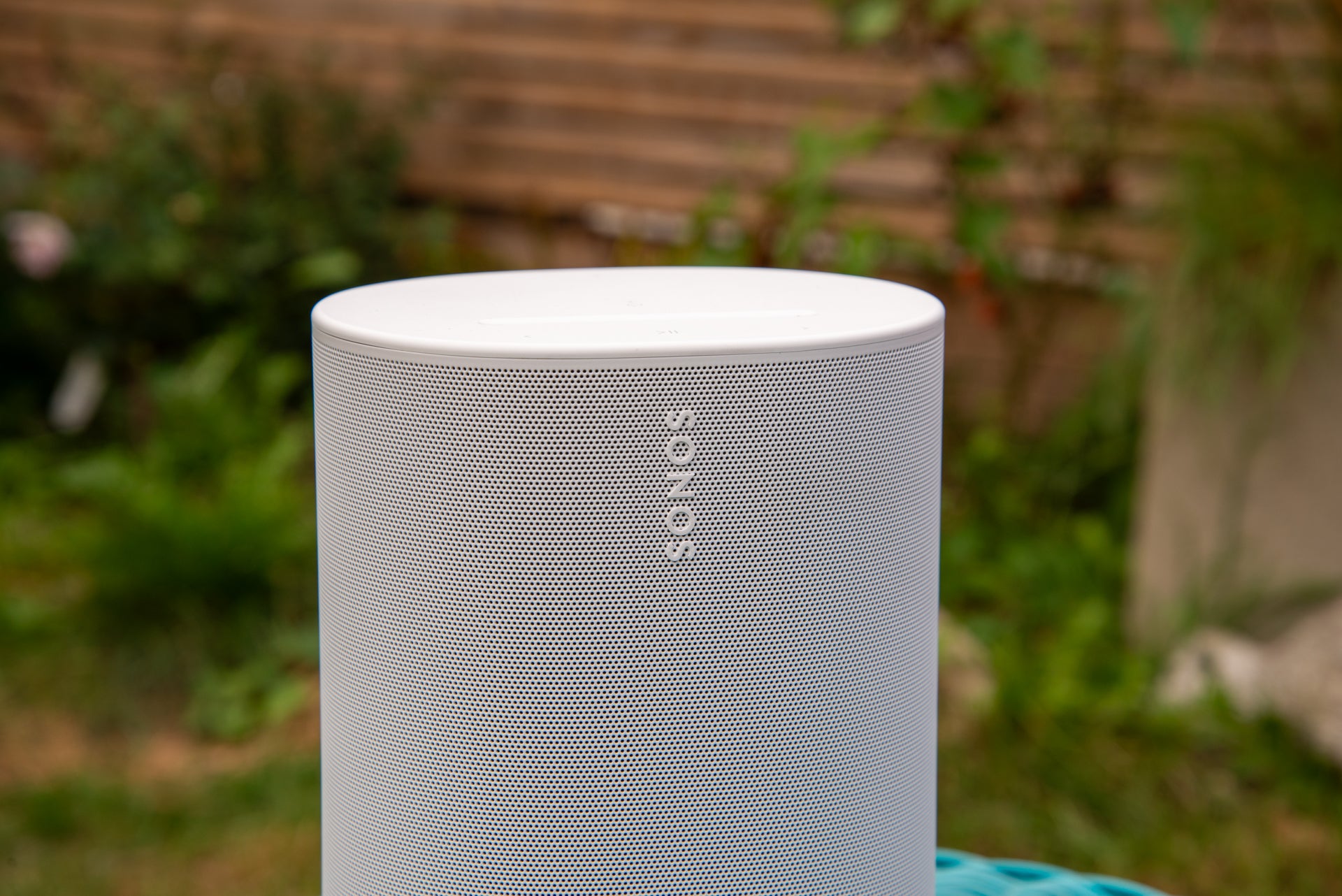
One of the main differences is the control panel on top. The old Move had the old-style touch buttons, which weren’t clearly labelled, and you had to look up how to skip a track. Here, the controls are much better. There’s a slider for volume control, plus dedicated play/pause and track skip buttons. It’s far easier to use this speaker than the old one.
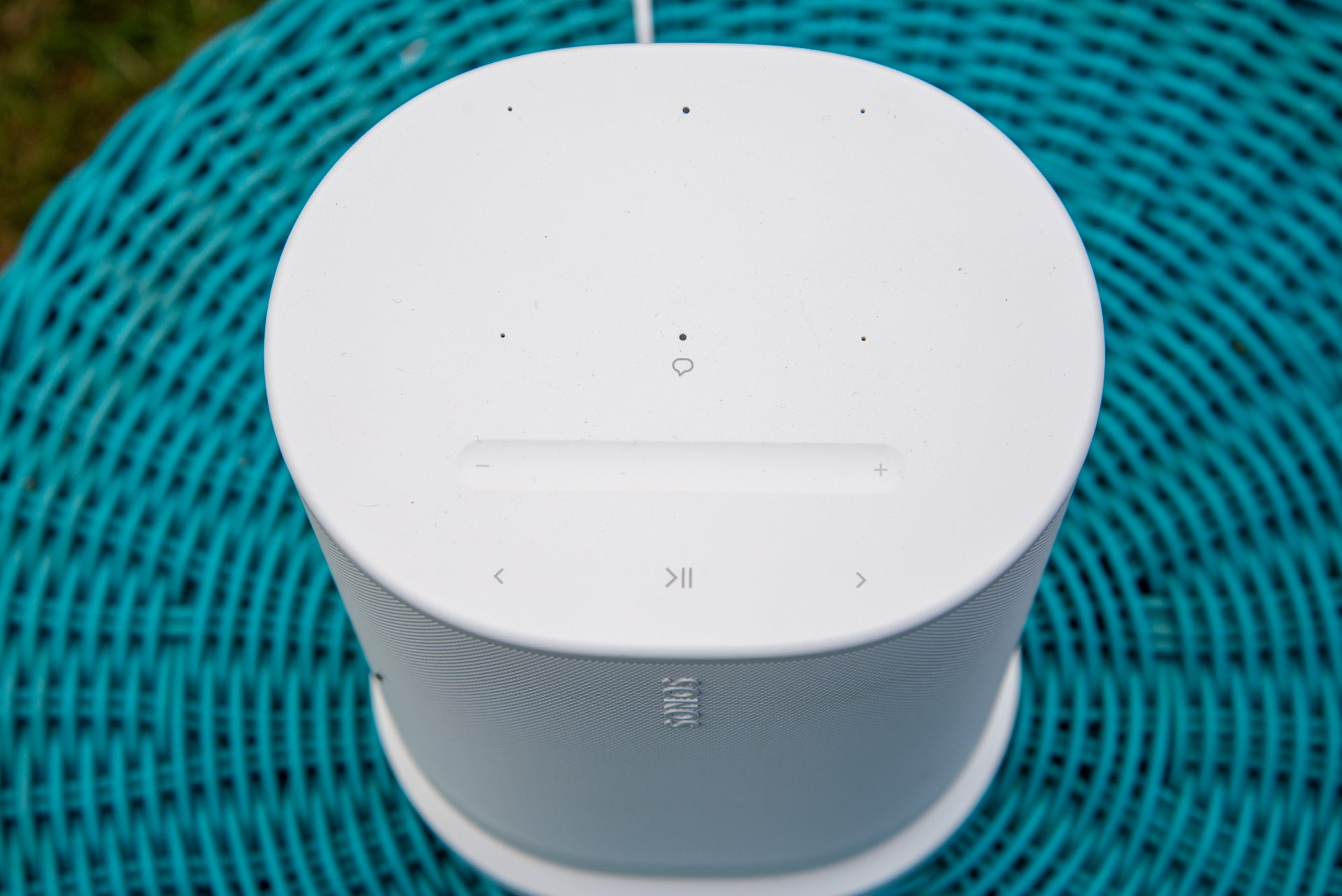
Flip the Move 2 around, and there’s a slight difference. The power and Bluetooth buttons remain the same, but here, there’s no Join button (that’s no longer needed, as the connection process has been streamlined) and a dedicated switch to turn the integrated microphone off.

USB-C is provided at the back. This can be used for charging the internal battery if you don’t want to carry the docking station around with you, or it can be used to recharge a device (handy if you need a quick power boost to your phone while you’re away from a power socket).
The USB-C port also doubles up as an input, although you’ll need to buy the Line-In Adapter to connect 3.5mm audio devices. Still, it’s good that Sonos has committed to multiple physical inputs, outside of streaming services only.
For use at home, there’s the same docking station as before. Drop the Move 2 into this and it will charge the battery and sit there on standby so that the speaker can be used inside just like any other Sonos speaker.

When you’re ready, grab the integrated handle and take the speaker where you want it, inside or out. At 3kg, the Move 2 does push the limits of what can be considered a portable speaker. Think of this more as a speaker that you can either pop out into the garden or take in the car rather than a slimline speaker for dropping in a backpack, and you’ll get the idea. For those who travel more, the Sonos Roam is what you’re after.
An IP56 rating means that the Move 2 is protected against dust, water, mud and, well, whatever else it may encounter outside. The only thing it’s not rated against is submersion in water. Have a party and leave this speaker outside, and you’ll not have to worry about it being ruined in the morning.
As with the original, the battery can be replaced by purchasing a kit from Sonos. Good news for longevity and good for the environment, too.
Sonos sells a few accessories for this product, including a £79 carry case and a more affordable £29 wall hook so the speaker can be hung out of the way. I’m tempted by one of the hooks for my garden to use when I have guests.
Features
- Auto Trueplay configuration
- Works with S2 systems
- Can be put into a stereo pair
Once the Move 2 is connected to its charging base, you can join it to an existing S2 system over Wi-Fi. It’s a Wi-Fi 6 device, as are the more recent Sonos speakers. I found it only took a few minutes to connect the speaker to my system, at which point it appears just like any other Sonos speaker. Any streaming services configured, including Spotify, Tidal, Apple Music, Qobuz and TuneIn, can simply be streamed to the speaker, and it can take part in multi-room music, too.
There’s also Spotify Connect and AirPlay 2 built-in, so you can skip the Sonos app and stream audio directly to the speaker.
Inside, connected to Wi-Fi, the Move 2 can also work as a smart speaker. Amazon Alexa and Sonos Voice Control are both options. The latter’s advantage is that it processes commands locally on the speaker and is designed specifically for music playback.
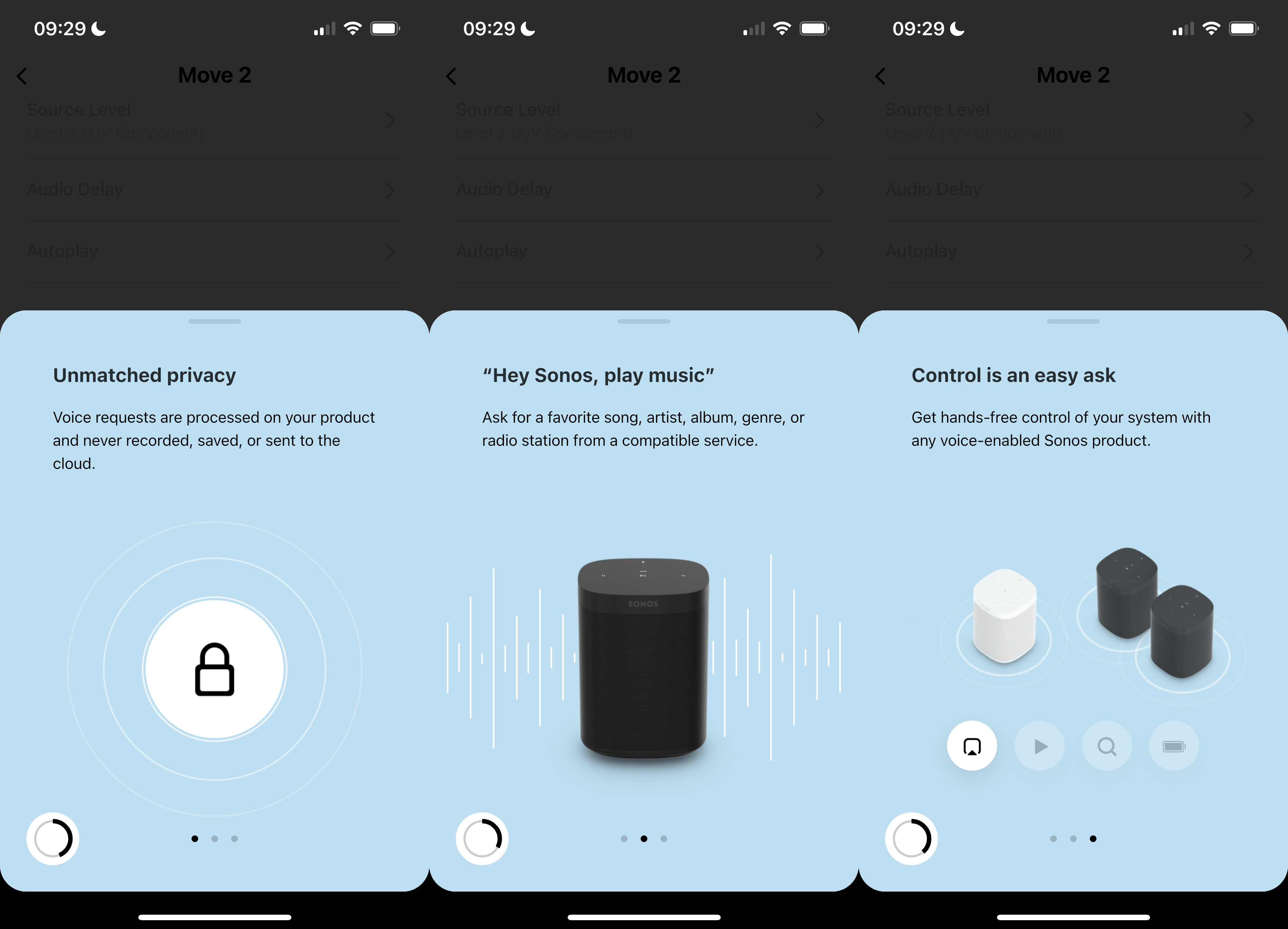
It’s possible to play specific music from Sonos Radio, Apple Music, Amazon Music, Deezer and Pandora; for other streaming services, such as Spotify, you must select the music from the app. However, once music is queued up, Sonos Voice Control does let you pause, play and skip tracks, as well as adjust volume.
Automatic Trueplay is available on this speaker, tuning the output every time the speaker is moved. The only requirement is that the microphone is switched on. Automatic Trueplay is similar to the system in the HomePod and HomePod mini.
It’s a particularly useful system on a portable speaker, which can be placed in a huge range of locations, from wide, open outdoor spaces to small rooms inside. Moving from a kitchen counter to a bookshelf, then to my garden, I found that Automatic Trueplay did a great job balancing the audio output so that the Move 2 always sounded good.
As well as operating as a standalone speaker, you can use two Move 2 speakers in a stereo pair if you really want to.
When you’re away from Wi-Fi (or you just want to play from a different source), you can tap the Bluetooth button on the back. This will automatically connect the speaker to the last Bluetooth device you used; a long-press puts the Move 2 into pairing mode.

Bluetooth 5.0 is supported on this model, rather than the older Bluetooth 4.2. Bluetooth 5 allows for high-quality streams, uses less power and increases range. For all effective uses, if you can see the Move 2, you can connect to it via Bluetooth.
Battery life is now rated for up to 24 hours, a staggering 13-hour improvement over the Move’s battery. This figure is based on the speaker being set to a ‘moderate’ level.
In real use, endurance depends on what you’re doing. I sat my speaker outside for an eight-hour session, which still had 54% battery life the next day. Based on my listening volume, I’d easily get to 15-hours+ on higher volumes. In other words, any length of party can be catered for with this speaker.
Tap the power button on the back, and the speaker goes into sleep mode, conserving energy until it’s used, while a long press will turn it off. As with its predecessor, the Move 2 will automatically switch to sleep mode after being idle for 30 minutes. If you want to push battery life further, there’s a Battery Saver option in the Sonos app that will automatically power the Move 2 off after 10 minutes of sitting idle.
Sound Quality
- Stereo audio
- Can fill large outdoor spaces
- Nice, boomy bass
The old Move had a single tweeter and one mid-woofer, but the Move 2 has two angled tweeters (stereo sound) and a mid-woofer, all powered by three Class-D digital amplifiers. As always, Sonos is a little cagey on the specs, but the speaker layout is similar to that of the Era 100.
Moving to stereo speakers rather than mono does make a difference, particularly when you’re not using a stereo pair. For starters, the speaker has a wider presence. Its audio sounds less directional and better fills the space, inside and out.
As the tweeters are relatively close together, you don’t get the stereo separation that a pair of speakers delivers. Fire up Foo Fighter’s Enough Space, and the opening guitar is designed to swirl between the left and right speakers. With separate speakers, you get the full effect of the guitars moving around you; with the Move 2, the effect is not as pronounced but the soundscape is wider than on a mono speaker.
There’s more subtlety to this speaker than the original Move. Listen to John Williams’ Imperial March, and the middle, quieter section is resolved in all its detail. With Simon and Garfunkel’s Sound of Silence, the harmonies are delivered beautifully, bringing the track to life as it should sound.
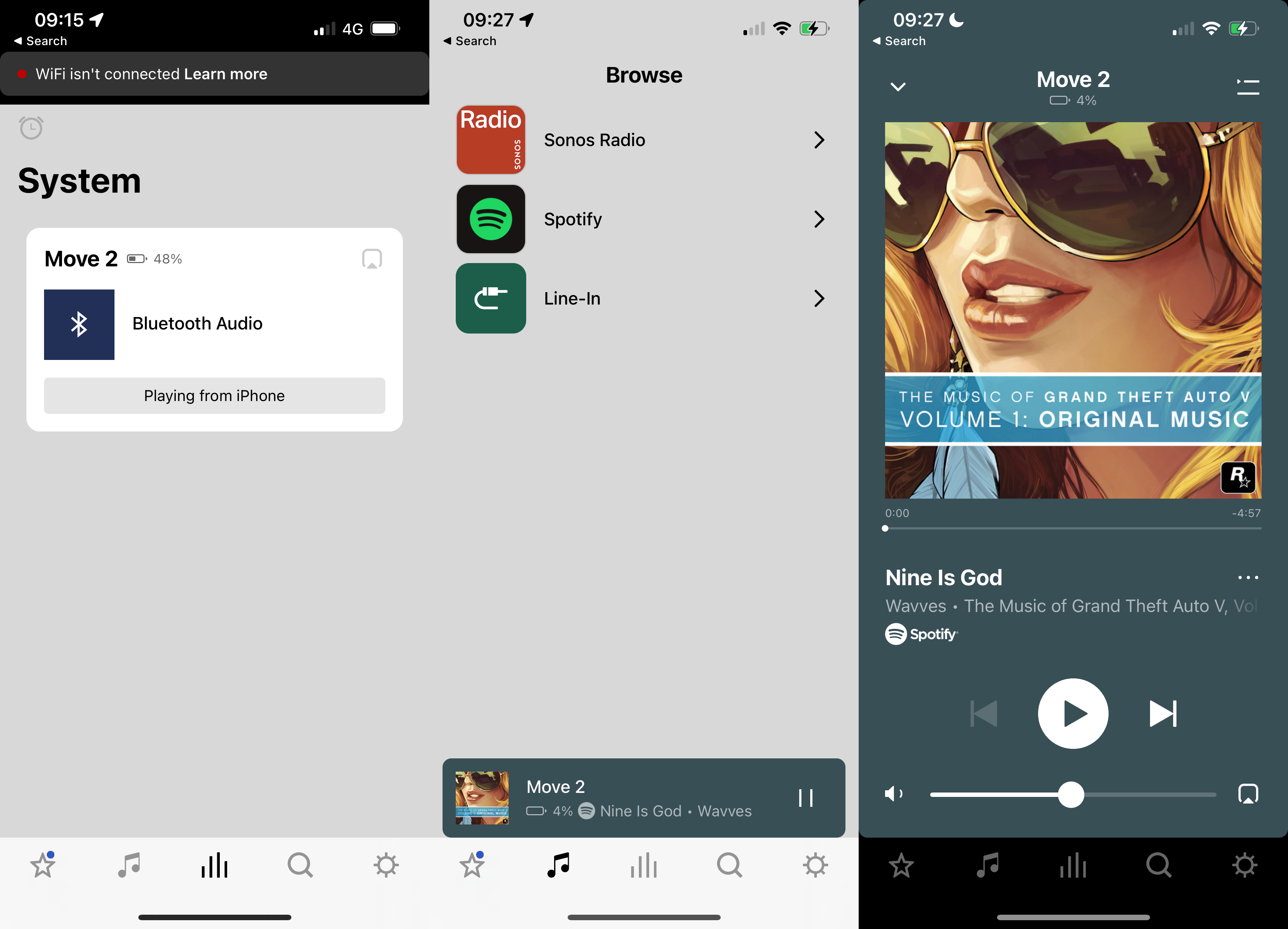
Pump in something more aggressive, such as Rage Against the Machine’s Bombtrack, and the Move 2 shows its capability. Its mid-woofer throws out bass with impressive weight and punch, but it never threatens to destroy balance; Zach de la Rocha’s hard-hitting vocals are absolutely clear.
That balance is evident listening to the Whiplash soundtrack, with the title song bouncing between the bass line and brighter trumpets and saxophones that the Move 2 handles well. If I’m being picky, I found the speaker a touch light in the midrange.
Turn up the volume as the DSP steps in to adjust the sound so that bass doesn’t get distorted or overwhelming. Inside, I found that up to volume 40 was good enough; outside, I could go louder, although I never needed to get anywhere near the maximum volume.
Switching between Wi-Fi and Bluetooth, I couldn’t hear any discernible differences. Of course, it’s easier to use Wi-Fi where it’s available, resorting to Bluetooth when that’s not an option.
It’s worth playing around with the equaliser settings, adjusting bass and treble to suit your listening preferences.
Latest deals
Should you buy it?
You want a flexible Sonos experience: Use the Move 2 inside like a normal speaker, but pick it up and move it around the house and into the garden when needed, all without sacrificing quality or features.
You want a speaker that’s easier to carry around: If you want something you can carry around with you, then the Sonos Roam or a traditional Bluetooth speaker may be a better option.
Final Thoughts
A premium over the old Move, the Move 2 at least justifies that price increase with better audio, thanks to stereo sound, and much-improved battery life.
Its combination of lift-and-move convenience, Bluetooth and Wi-Fi audio, and full Sonos integration make it unlike anything else, bar its predecessor. If you want a speaker that works as well in your garden as it does in your living room, then there’s nothing better.
How we test
We test every wireless speaker we review thoroughly over an extended period of time. We use industry standard tests to compare features properly. We’ll always tell you what we find. We never, ever, accept money to review a product.
Find out more about how we test in our ethics policy.
Tested across a week
Tested with real world use
FAQs
Yes, Sonos provides a kit, so you can replace a battery that’s damaged or not charging.
Yes, although they can only be used for music playback and can’t be used as rear speakers for a home theatre system.

